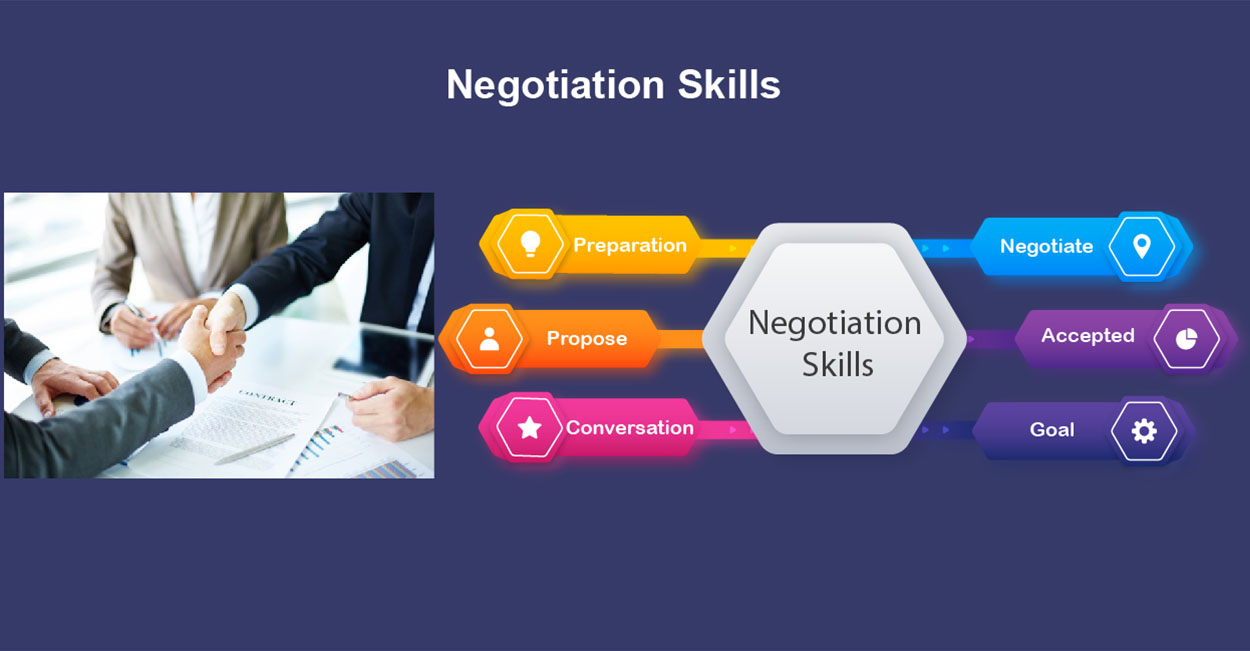You have worked so hard in the sales process right from the initial meeting until this stage. The buyer has confessed what they want and you have also ideated multiple solutions. The buyer is convinced that you are a capable organization that can solve their problems. They have asked you to submit a proposal and you have done it. They have now called you for a Negotiation.
The familiar uneasy feeling gets into us. Till now, we had nothing to lose as we were discussing and debating on ideas that were applicable for someone else and now the ones that will work for this buyer. However, the stakes are high now on a relative basis. You have come to the last but one step in the sales cycle. There is a number attached to this opportunity. This meeting can be a make or break for you. You could close or you could lose.
You will be asking yourself about what you can give and what you cannot. Even if it sounds reasonable, you still will be unclear if your management will accept these fair (according to you) expectations of the buyer.
You know that for a fact. Even if the buyers initially accept all the terms, there is always a temptation for them to squeeze a bit more from us – Buyers Ego or their perception that we will keep some buffer as discounts and will give only if they ask us. Handling this well will get us the contract.
Think about it from the buyer’s point of view.
At a high level, Negotiation is a perceived gap between what the buyer feels about anything that is offered by the seller. A gap is something that the buyer perceives any terms to be. This is because of the assumptions that the buyer will have about this entire implementation.
They will have their own versions on the What (Product), When (Timelines), How (Solution), How much (Price). They will also have their versions on the terms and conditions the purchasing organization of the buyer will have in engaging and handholding the vendor.
The gap can be on the solution, service, price, warranties and legal terms offered by the seller. It is in the hands of the seller to bridge the gap and convince the buyer and narrow the gap.
Negotiation is the perceived gap between the buyers Fair expectations Vs What your terms and conditions are. You will have to strike a balance and make it a Win-Win for both of you. Click To Tweet
Let us start with what could be the gaps… Why would your buyer want to negotiate with you in spite of a need to buy from you? Let us discuss both good and bad reasons.
Budget Shortage
Budgets for spend is usually approved at the end of the earlier financial year. The business heads get together and present what they would need to spend in order to achieve certain business goals. The management sanctions those goals. Multiple initiatives fight for this budget. The solutions (products or services) are decided along with their ballpark budgets also.
Hence your buyers will have to stick on to the budget that has been allotted to them for this pain point. If your solution is factored as part of the budget, they have the money and will negotiate only if your proposal cost exceeds the money they have been allotted. Alternately If your solution is not factored as part of the previous years budget, then they fall short on the budget. Alternately, they have to give in something else to purchase your solution.
This situation happens when the Need Recognition happens suddenly and the buyers become aware of the high impact of the problem. They want to solve the problem desperately. They don’t have the funds or they don’t have enough of the funds to pay for the quote you had given.
Conflicting priorities
Even if they have factored your solution as part of their budget in the earlier year, there is a chance that they might have overrun their budget on some other high impact project. This means, that they would need additional money to finish that one which they would like to explore if they can get some additional cash by asking you a discount.
Non-Monetory
All that is negotiated need not be only money. Negotiation can happen on anything that you have written in the proposal. This can range from the scope, payment, payment terms, delivery dates, extended warranty, and legal terms to name a few
Value proposition not conveyed
At multiple times, we end up buying something at an extremely high price than we should. This is because we believe in the value and hence are willing to buy. On the contrary, we have also decided against the purchase of many things because we believed that it is not worth the price or we have also tried negotiating hard and then bought it. The concept discussed here is value.
As a salesperson, you might not have shown what value the solution is worth. Sometimes, it is also inevitable that we will be unable to demonstrate value in spite of us doing out best. This could be because the buyer is either too ignorant or the pain point to the organization is of low impact.
You have to demonstrate the value that your solution will give to the buyers and the impact it will create. How do you demonstrate the value?
Begin with the consultative selling model.. Create a need in the minds of the buyer as early as you can. Ideate with them and establish your position of superiority. Quantifying the value is all about making money or saving money. This can be done through revenue, cutting costs using people, tasks, automation, etc. Doing it Faster, Better, Cheaper.
If the buyers are convinced about the value, they would not want to lose you as a vendor. They would go all out and bat for you internally. They would go to their management and talk about the benefits of the solution. They would also talk about the shortage of the money they have in adopting the solution. They will now ask for additional budgets to be allotted to them so that they can purchase your solution.
Flinching Mindset
This mentality is there in all of us. We don’t want to accept the price that is being thrown at us. We would just want to negotiate for the sake of negotiating and squeeze something out and get some happiness.
If they don’t get the value, they will only come back to you and will ask you to reduce the price.
Negotiation Buffer
Seasoned buyers know that you will quote slightly higher than your desired price. This is because you will be able to give something to them if they ask for a discount. They would not want to lose that. Hence they will negotiate with you.
Competitors Quotes
You had all the evaluation parameters in your favor. You also felt that your pricing was right. You felt that you will win the deal. However, your buyer called you and said that your price is too high and they are going in with another vendor that is offering a good price. To your surprise, you found that the company that won the deal is a very small company. How did this happen?
Every buyer will almost always pick up 3 quotes for comparative purposes. There is a fair chance that the other vendors would have quoted a low price. The proposals in the written format could be a bit hazy and might not spell all the details as much as you would have. Sometimes, the buyers may even assume certain things out of the proposals.
When two proposals are almost the same, this may give the perception that both the vendors are almost similar in terms of the capabilities. So, they would obviously think of why they should pay you so much compared to the low cost that the other vendor would offer.
A buyer negotiates for a variety of reasons. Find out the reason as early as you can. This will help you to handle the negotiation scientifically. Click To Tweet
Buyers Ego
We have seen these types of buyers many times. The buyers just take pride in beating down the vendor on hard terms. They then go around the organization and talk about how much they saved for the organization by negotiating hard.
We could list multiple other reasons like the ones we discussed above.
So, the first thing you have to do is find out Why you are being called for a negotiation and who are you going to be compared with???Once you establish a position, you can then figure out what to give and what not to give. Sometimes, you can decide not to give anything if you figure out that their position is weak.
So, when you are designing a proposal template, you should have a list of Negotiable and Non-Negotiable terms. In a deep dive negotiation, the buyer also should feel good that they have got something out of it. You should think about the buyers’ position also. You have to make the buyer give an entire list of what they would like to negotiate.
As much as you would feel bad that the buyers beat you down so hard, you should anticipate that the buyers will also feel bad that you have beat them down. So, giving away a few things and then saying how much more you can give and asking the buyer to accept the other terms can be a good way to negotiate.
Establish a position against multiple types of competition. You will then know how to differentiate when you would have to compare with your competition. Click To Tweet
What can you do to avoid the negotiation as much as possible?
As discussed earlier, the buyers will not do a hardball negotiation, if they are convinced that we are the people who can deliver. If we sell value and thought leadership from the first touchpoint onwards, we can get the prospect focus more on the value they would get and not necessarily at the price.
We can get them so excited that they want you to implement at all cost and will go all out to defend your proposal to the other stakeholders within the organization if those other decision-makers would object to any of the terms. Your initial point of contact buyer would even advise the other buyers or the procurement and would ask them not to antagonize you as you might say no.
What can you do if the buyer will still negotiate?
If the buyer will still negotiate, the best way to respond to that will have to be on value. It will be a weak and an easy way for the prospects to beat us down if we would take the route of cost of producing the solution to be high. Pricing based on cost is not the best strategy. It would also be sound Salesy if we would say that we would provide the best service as no other company will say that they will not provide the best service.
Spend a good amount of time in how you can build value from the initial touchpoint. There will many industries where the competition will be very high. This will give a chance for the buyers to behave like your products or services are commodities. They will unfairly compare you with the smallest company and will ask you to match their prices. A well laid out plan of engagement with the prospects will help you make more money out of the same sale.
Also, explore if you can talk on a few things that are non-monetary in value. You can ask what you can take if you have to give. This can be a follow on business, a higher percentage of the payment as advance, payment terms being faster, a video testimonial on the website, a couple of references, etc.
Your buyer will be happy to oblige because they are getting a good solution from a good vendor at a good price. You will also feel good at the end of the negotiation because you also got something out of it.
Your smallest competitor with the lowest price can tempt your buyer to match the price. Establish your value and differentiate yourself to knock out the unfair comparison. Click To Tweet
Summary
You have to get into the consultative mode of selling right from TouchPoint No. 1. You have to get into understanding the pain points as early as possible. You have to increase your position from being another vendor into being a consultant. That will insulate you from being compared with the other competitors.
You should also understand the types of competitors and should have a point of reference (position) against them. Once you understand the types of competitors, you should then have comparisons done ahead of time. You should use those spontaneously when your buyers will not give you enough information about the competitors but will ask you to compare.
Do Share this in your preferred social media channels if you found this article usefulAlso, Subscribe to receive constant updates on B2B Sales tips and techniques in your Inbox.
Visit Our Negotiation Skills training Services
Visit our youtube channel to get more insight on B2B sales and on digital marketing


















